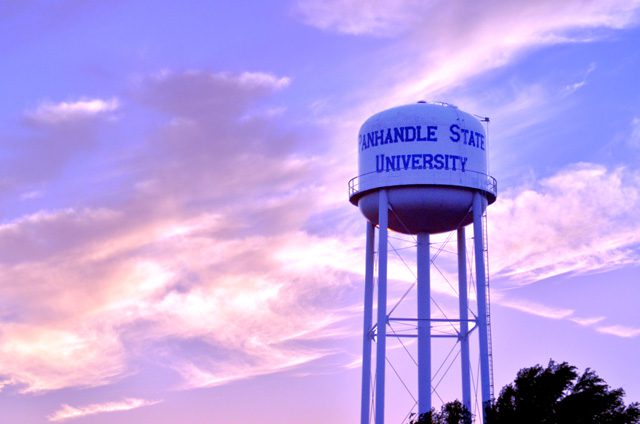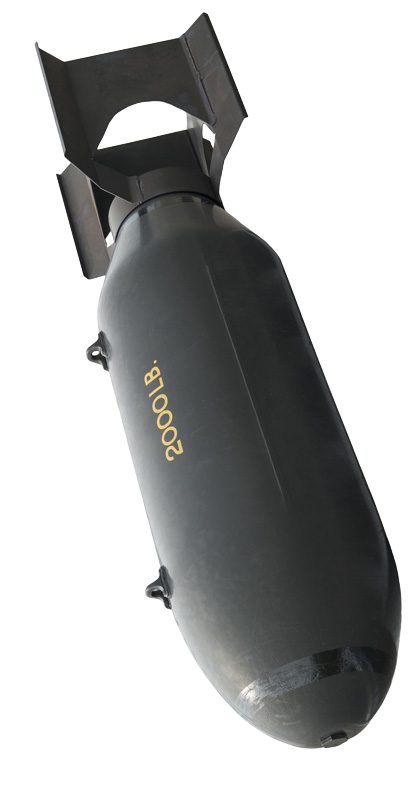
[dropcap]Oklahoma[/dropcap] is one of the most distinctly shaped states in the country, and we owe it all to our Panhandle. It’s only 34 miles wide but over 160 miles long, with three counties of near-equal size and a total population of about 28,000.
But what actually goes on in this remote, rural part of the state? Did you know that many Panhandle natives refer to central Oklahomans as “downstaters”? The Panhandle, although somewhat remote and spread out, still has plenty to offer in terms of sightseeing and community.
The Land
The Panhandle’s unique shape means it is closely bordered by other states: Kansas, Colorado, New Mexico and Texas. And this part of Oklahoma also includes a wide range of terrain, because the Panhandle’s elevation increases the further west you travel.
“Our classification is high plains, but I consider the Panhandle to be the foothills of the Rockies,” says Tucker Heglin, park manager of Black Mesa State Park. “Within the length of the Panhandle, the elevation rises 2,500 feet. It’s hard to imagine when you’re driving along it, because it doesn’t seem like there’s much to see, but the highest point in Oklahoma is actually just about 15 miles from the nature reserve in our state park.”

Black Mesa State Park is near the town of Kenton on the western edge of the Panhandle. To even just navigate to the park, visitors need to drive over four miles off the main highway.
“We are way off the beaten path,” Heglin says, “but I think that’s something special about the park. It’s a great place to get away from it all. You might not get cell phone reception, but I think we all need that from time to time.”
This far west, with a little luck, you can find wildlife uncommon to the rest of the
state, including bighorn sheep up on the mesa that migrate to and from Colorado.
“There’s a herd of about 600 of these sheep that move into the park area in the fall and early winter every year,” Heglin says.
The Panhandle is also known to be a star gazer’s paradise due to its intensely dark skies.
“Black Mesa State Park is known for being one of the darkest skies in the nation; there is very little ambient light,” Heglin says. “My favorite times for stargazing are especially in the early fall and late spring.”
The Panhandle also hosts the Okie-Tex Star Party at “Camp Billy Joe” just southeast of the tiny town of Kenton, outside of Boise City. Over 600 people gather at this campground every year in late September, Heglin says, to watch the skies for about 10 to 12 days.
 The History
The History
If you thought the history of the Panhandle was much like the rest of the state, think again. Three different Native American tribes lived in the area until about the 1400s, according to the No Man’s Land Historical Society, and when they later moved on due to a drought, nomadic tribes moved in. When white Americans began moving out west, they also populated this area differently than the rest of Oklahoma.
“We were settled long before the rest of the state. And it wasn’t from land runs; the Panhandle was settled by speculators wanting to homestead,” says Sue Weissinger of the No Man’s Land Historical Society.
The No Man’s Land Historical Society runs the No Man’s Land Museum in Goodwell, where Weissinger is also a curator. Weissinger says she became interested in the museum when she started to learn more about the Panhandle’s fascinating history.
“The history in this museum goes back as far as we know in paleontology,” she says. “Ancient animals have been found in the Panhandle, and the museum shows this history, too.”
Since that time, the land has changed quite a bit, Weissinger says.
“There are still very few trees in the Panhandle, but the ones that you do see are all planted,” she says. “When the first [white] settlers came out here, there were no trees at all. Because of that, these settlers relied on alternate forms of heat, like cow chips.”
The Sights
Speaking of cow chips, these historical … chunks … remain important to the Panhandle in this modern age, believe it or not. In the town of Beaver in Beaver County (the easternmost county in the Panhandle), the longstanding history of the cow chip is presented in an entirely different way with the World Cow Chip Throwing Championship.
Yes, you read that correctly. Once a year, locals and participants from the surrounding region gather in Beaver to see who can throw a cow chip the farthest. Legend tells that the tradition began as a joke but then, somehow, it stuck.
“The stories I have been told vary, but the one that sticks out the most is that the Chamber board members in 1969 were meeting and throwing around ideas (a few drinks were involved), and someone threw out the idea of throwing cow chips and making it a competitive event. It was said in jest but the idea stuck and the rest, as they say, is history,” says Kelsey Short, president of the Beaver Chamber of Commerce.
The competition is held each April, and each participant chooses two chips to chuck from a wagon. But if you’re a novice, don’t underestimate your high-caliber competitors.
“If you’re coming out to win, remember you’re going to have to throw your chip more than 188 feet and 6 inches,” Short says. “Our current world record holder is Drew Russell. He’s a hometown guy living down state, and he comes home each April to visit family and throw chips.”
Short hears some surprise when outsiders learn about the competition in Beaver.
“Most people think I’m joking! They usually find the name of our town amusing and when you add in throwing cow poo to the mix … people want to know more,” Short says.
But if cow chips aren’t your thing, the Panhandle has other activities to offer, including the Cimarron Heritage Center in Boise City. Boise City is located in Cimarron County, the westernmost Panhandle county.
The Cimarron Heritage Center encompasses much of the area’s history, but one interesting bit of trivia about the area is that Boise City was the only spot in the continental United States that was bombed during World War II.
“Off a base in Texas one night, a small group from the military base was on a practice run and got off course, and then accidentally dropped some bombs in the Boise City area,” says Judy Broaddus at the Cimarron Heritage Center.
During this incident, which took place in early July 1943, six bombs were dropped in and near Boise City, but fortunately there was only small property damage and no casualties. Today, one of the sites is marked with a small commemorative plaque.
Established in 1994, the Cimarron Heritage Center contains exhibits that display different areas of history, including the Dust Bowl of the early 1930s, which hit the Panhandle particularly hard. The entrance to the museum is a house designed by Bruce Goff.
“Goff was a student of Frank Lloyd Wright, so when you visit the museum, you can go through the house and then on to the other areas, such as our 1920s schoolhouse and the windmill exhibit,” Broaddus says.
Another draw of the Panhandle is Guymon’s Pioneer Days Rodeo. Taking place during the first weekend of May every year, Pioneer Days includes a parade, carnival, 5K run, rodeo queen pageant and more. And not to mention the “mutton bustin’,” where children ride sheep and hang on for dear life as long as they can.
Guymon is known as the Saddle Bronc Capital of the World. For those who might not know, saddle bronc riding is a rodeo event similar to bareback riding and bullriding, but requiring more technical skills. Spectators can see these skills in full force at Pioneer Days.

The School
Guymon has the largest population of all the Panhandle’s towns by far (at about 12,000; the next-largest is about 6,000), but Oklahoma Panhandle State University in Goodwell (population around 1,200) is also regarded as a hub of activity. Goodwell is in Texas County, the central county of the three in the Panhandle.
Dr. Tim Faltyn, the 15th president of OPSU who hails from a long line of family ranchers, says the university is not only a nucleus for Goodwell, but also for the region in general.
“We’re the biggest draw of new talent and prepared workforce,” Faltyn says. “You would be really surprised by how many people came to school here and never left because they love the area, the beauty of the landscape – yes, if you look around, it’s gorgeous, most people don’t take the time to look – and the people. It’s a truly remarkable place that is often overlooked or, truth be told, never seen because people don’t give it a chance.”
The university itself is known for its Bachelor of Nursing program (which is both popular and high-quality, Faltyn says), its business program and its degrees in science and agriculture. Recently, the education and arts tracts have grown, which is great because “the world needs teachers and artists,” Faltyn says.
Because the Panhandle is closer to four other states than to “mainland” Oklahoma in many places, most of its students are from out of state. This brings a lot of diversity to the region.
“We have alumni in all 50 states and 26 countries. We take good people and make them great. But if you show up, be willing to work and do your part,” Faltyn says.
But in addition to the university, what else draws students to this area? A strong economy doesn’t hurt.
“The Panhandle of Oklahoma has the strongest economy in the state. If you separated the five state regions from the rest of the U.S., we are among the most prosperous areas in the nation with lowest unemployment rate in the state and some of the highest per capita incomes,” Faltyn says. “There is a lot that is overlooked about the Panhandle. On a personal note, I love the landscape and the wildlife. Those two things combine for a way of life that is excellent for raising a family and riding my horse across the southern High Plains.”
The People
Maybe it has something to do with the nature of small communities, but the people of the Panhandle are especially proud of their region. Oklahoma Panhandle State University history major Anyssa Barbosa is not a native of the state, but she has learned about Panhandle people during her years at school.
“I truly believe the people of the Panhandle make this part of Oklahoma unique,” Barbosa says. “The Panhandle breeds resilient individuals, and after being here the last three years, going on my fourth, I’ve met some of the most amazing, strong-willed people who’ve taught me that the Panhandle has great rewards if you’re committed enough to stay here and give it all you’ve got.”
President Faltyn agrees the residents of this part of the state make the region special.
“They have a genuineness and grit that you don’t find anywhere else in Oklahoma,” he says. “I’ve literally lived in all four corners of the state and in the middle as well. The people of the Panhandle are smart, tough and don’t put up with pretenders.”
Weissinger of the No Man’s Land Historical Society says the people of this area have a spirit of camaraderie.
“The Panhandle is all about the people,” Weissinger says. “We have a wonderful, sharing spirit of community. It’s the type of place where if someone gets sick in the community, everyone jumps in and helps.”






















 The History
The History